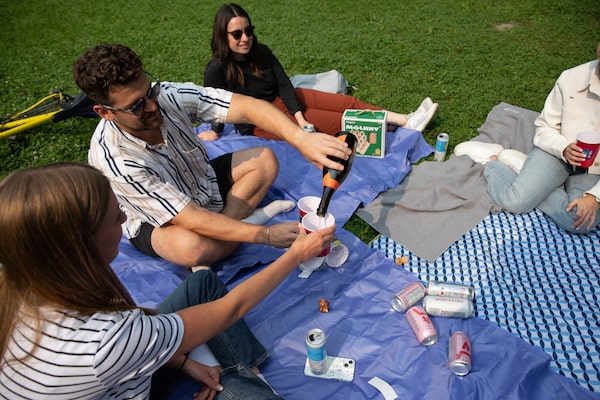
A group of people drink alcohol at Trinity Bellwoods Park in Toronto on Aug. 2, 2023. Through a two-month pilot program launched last week, Toronto became the first city in Ontario to allow drinking in select parks.Arif Balkan/The Globe and Mail
Toronto is the latest Canadian city to crack open the lid and permit alcohol in parks amid continuing debates around the impact on public health.
Through a two-month pilot program launched last week, Toronto became the first city in Ontario to allow drinking in select parks. Ontario’s capital joins other large cities in Canada, such as Edmonton, Calgary and Vancouver, where there are now permanent policies allowing alcohol in select parks year-round after starting as pilot programs.
Communities across the country have been debating whether – and how – to allow alcohol consumption in public spaces. Proponents have argued for relaxed liquor laws to legalize what people are already doing, while opponents have warned that expanding where people can drink would increase the harms associated with alcohol consumption.
Those debates were amplified by the COVID-19 pandemic, as people were eager to socialize more outside when restaurants and bars were closed.
Canada’s updated guidelines on alcohol usage, released by the Canadian Centre on Substance Use and Addiction (CCSA) earlier this year, recommend that people consider reducing their use of alcohol. The guidelines say consuming more than two standard drinks a week poses a “moderate risk” of alcohol-related consequences, including breast and colon cancers.
Starting today, drinking allowed in 27 Toronto parks under pilot project
Dan Malleck, a health sciences professor at Brock University with a focus on drug and alcohol regulation, said North American culture has a “weird relationship” with liquor when it is consumed in a public setting.
Prof. Malleck said a lot of people drink alcohol responsibly, but since drinking in a public park has long been an illegal activity it is seen as a deviance and the public view jumps to the worst-case scenario of violence or drunk driving.
“There’s this sense that because there’s less control, we will then act like maniacs, and we tend not to do that,” he said.
Prof. Malleck said he doesn’t expect to see a lot of issues with the pilot in Toronto and foresees an experience similar to other cities that already have such policies.
The cities where drinking in parks has been legalized have reported that the rollout has been largely successful.
A Calgary survey from its 2021 pilot found that 65 per cent of respondents supported the program. Of those who participated, 73 per cent said they visited parks more often because they were allowed to drink.
Edmonton had some issues with non-compliance at the start of its initial pilot, with people drinking in parks not part of the program, prompting the city to add large signs in these areas to signal that drinking wasn’t permitted.
In Montreal, alcohol is permitted only in designated picnic areas in parks during a meal.
The debate in Toronto took a little longer with the city deciding to hold off on allowing alcohol in parks last summer. But this year, the new council approved a two-month program limited to 27 parks. City staff initially selected parks in all of the city’s 25 wards, but individual councillors were given the opportunity to withdraw their ward from participating.
The program permits alcohol consumption in these select parks until Oct. 9 during park operating hours. Residents are encouraged to fill out a survey on the city’s website throughout the pilot that will be used to inform next steps, including potential expansion.
Carleton Grant, Toronto’s executive director of municipal licensing and standards, told reporters at a launch event at a west end park last week that enforcement efforts will focus on education and only issue tickets where non-compliance is “egregious.”
On the other side of the issue, public-health experts say providing more spaces to drink could increase the risk of associated problems.
Tim Naimi, director of the Canadian Institute for Substance Use Research at the University of Victoria, argued that there could be an increase in alcohol-related crimes, including assault and vandalism, as a result of the expanded drinking locations.
He also said alcohol costs taxpayers a lot of money, citing data from a joint project between the school and the CCSA that projected alcohol-related costs in Canada of $19.7-billion in 2020 for health care, criminal justice and lost productivity.
“If we’re trying to drink a bit less as a society to reduce those costs and harms and meanwhile we make alcohol more available to be consumed, those two goals are not compatible with one another,” he said.
Susan Bondy, associate professor with the University of Toronto’s Dalla Lana School of Public Health, said the idea is contentious because people have opposing views when it comes to alcohol and some don’t want to be around it in a public setting. She said any policy allowing alcohol needs to focus on harm reduction, including proper enforcement and messaging around responsible consumption, as well as access to water fountains and washrooms.
“People have very legitimate conflicting views and experiences with alcohol so it’s understandable that any form of alcohol policy is playing one person’s values opposite another person’s,” she told The Globe and Mail. “It’s always a matter of striking the right balance.”
Legalizing alcohol in parks and putting parameters around where people can drink could also minimize conflict between residents, Dr. Bondy said, as people who don’t want to be around alcohol can choose to go to a park where it isn’t permitted.
 Dustin Cook
Dustin Cook